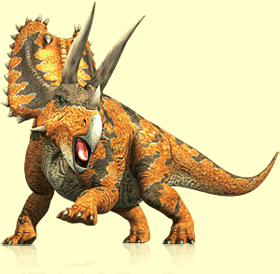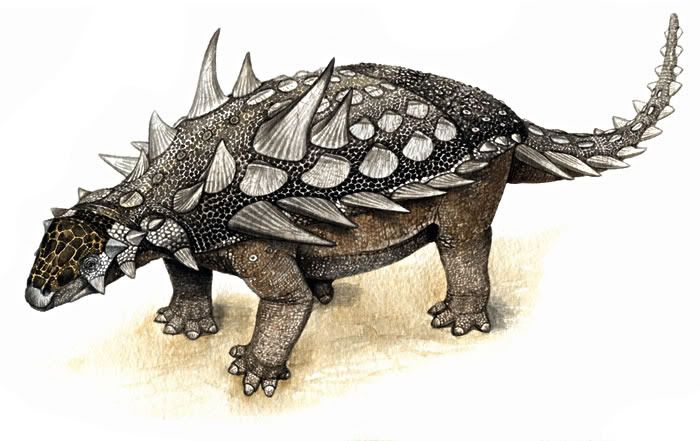Megalodon |
Wednesday, December 7, 2011
Megalodon-The Fiercest Shark Around
Posted by Unknown at 7:12 PM 0 comments
Labels: meat eater, megalodon, predator, prehistoric, prehistoric animals, prehistoric sharks, shark, sharks
Wednesday, August 24, 2011
Gastonia Is Built Like A "Tank"
He has lots of heavy armor so he moves slow. He had poor eyesight (bet he wishes he had glasses or a magnifying glass) but a strong sense of smell and hearing (sneaking up on him would not be easy). He has a solid bony plate over its hips, which allowed him to crouch down to protect his vulnerable stomach from attacking predators. The spikes covering his body and the spikes on his tail were used like "chainsaws" as offensive weapons to protect itself from an attacking predators like Utahraptor.
Gastonia lived in the USA, North America in the early Cretaceous Period (142-127 million years ago) and Gastonia was a plant-eater. One of Gaston neighbor was a predator named Utahraptor. Talk about neighbors who don't get along! Eeeeep!!!!
Gastonia was named after paleontologist Robert Gaston. He made the first discovery of Gastonia fossilized remains in Moab, Utah, in 1989. Thank you Robert Gaston!
Posted by Unknown at 8:21 PM 0 comments
Labels: dewy and the dinos, DINOSAURS FACTS, gastonia
Saturday, July 16, 2011
Andrewsarchus
 Andrewsarchus (and-rooz-ark-us) was as a big as a rhino! Its head looks like a wolf a not so nice wolf LOL! Used to eat meats like primitive whales and had strips like a tiger. Andrewsarchus names mean "Andrews' beast" because its named after Paleontologist Roy Champman Andrews who was the one who found Andrewsarchus. Roy was the role model for Indiana Jones
Andrewsarchus (and-rooz-ark-us) was as a big as a rhino! Its head looks like a wolf a not so nice wolf LOL! Used to eat meats like primitive whales and had strips like a tiger. Andrewsarchus names mean "Andrews' beast" because its named after Paleontologist Roy Champman Andrews who was the one who found Andrewsarchus. Roy was the role model for Indiana Jones Posted by Unknown at 12:44 PM 0 comments
Labels: aisa, Andrewsarchus, dewy and the dinos, Indiana, roy champman, wolf
Wednesday, June 15, 2011
Nanotyrannus The Small Version Of The T-Rex
Posted by Unknown at 1:20 PM 0 comments
Labels: charles w gilmore, deadly dinosaurs, dewy, dewy and the dinos, Dino Books, nanotyrannus, T-Rex, wyoming
Monday, June 6, 2011
Diplodocus
| Lived Late Jurassic period, about 156-144 million years ago. Found in Western U.S.A. |
Posted by Unknown at 8:35 PM 0 comments
Saturday, April 30, 2011
Ceratosaurus
 Ceratosaurus (Keh-RAT-oh-sore-us) which means "horned lizard", goes with out saying he had 3 horns one above each eye and one above his nose. He weighed bout 2 tons and was about 20 feet tall. He used his incredibly strong and flexible tail to swim after its prey like a giant fish, crocodiles, and alligators. They also like to dine on plant-eaters like the iguandons, stegosaurus, and even the giant sauropods. It is not know if they hunted in groups or by themselves.
Ceratosaurus (Keh-RAT-oh-sore-us) which means "horned lizard", goes with out saying he had 3 horns one above each eye and one above his nose. He weighed bout 2 tons and was about 20 feet tall. He used his incredibly strong and flexible tail to swim after its prey like a giant fish, crocodiles, and alligators. They also like to dine on plant-eaters like the iguandons, stegosaurus, and even the giant sauropods. It is not know if they hunted in groups or by themselves.Don't Forget About Mother's Day!


KudoSurf Me!
Posted by Unknown at 10:19 AM 0 comments
Labels: 3 horned, Allosaurus, Ceratosaurus, Jurassic-fight club, prehistoric Dinosaurs. meat eaters, USA
Wednesday, April 6, 2011
Time Out For Mother's Day
Looking for some gifts for Mother's Day? I found some funny, some sweet, and some inspirational. Don't forget to get your mom and grandmother and all the other mothers in your life.
 |
| A mother's memorar |
 |
| A beautiful necklace that says "A Mother Holds Her Child's Hand For A Short While And Their Hearts Forever" |
 |
| Give mom a light up globe that says 'I love You' |
 |
| First Mother's Day Picture Frame |
Posted by Unknown at 8:31 PM 0 comments
Labels: family, gifts, gifts for mother's day, love, may, mother's day, what to give mom
Tuesday, March 22, 2011
Pentaceratops

 Pentaceratops (PEN-tuh-SER-uh-tops) means "Five-Horned Face" it eats tough, low-growing plants and lives coastal floodplains, and the state it used to live in was New Mexico and Colorado. Pentaceratops were about 25 feet long, 7 feet tall at the hips, and 3-4 tons about the same as an Asian elephant.
Pentaceratops (PEN-tuh-SER-uh-tops) means "Five-Horned Face" it eats tough, low-growing plants and lives coastal floodplains, and the state it used to live in was New Mexico and Colorado. Pentaceratops were about 25 feet long, 7 feet tall at the hips, and 3-4 tons about the same as an Asian elephant.
A new genus and species of Ceratopsia from New Mexico, Pentaceratops sternbergii (American Museum novitates)
Posted by Unknown at 7:43 PM 0 comments
Thursday, February 24, 2011
Brachiosaurus

Herds: Brachiosaurus probably traveled in herds and may have migrated when they wasted their local food supply. Eggs: Brachiosaurus have hatched from eggs, like other sauropods. Sauropod eggs have been found in a linear pattern and not in nests; presumably the eggs were laid as the massive reptiles was walking. It is thought that sauropods did not take care of their eggs. Brachiosaurus Life Span: Sauropod life span may have been as old as 100 years old. Brachiosaurus Defense: Brachiosaurus's best defense was size. In colluding, its long tail could whip away most predators. Also, Brachiosaurus had leathery skin, everyone though this wasn't much of a defense against predators, sharp Theropods teeth. They also had one claw on the front feet that were used protected young.







Posted by Unknown at 11:18 AM 0 comments
Labels: brachiosaurus, dewy and the dinos, dino, Dino Books, prehistoric Dinosaurs



























